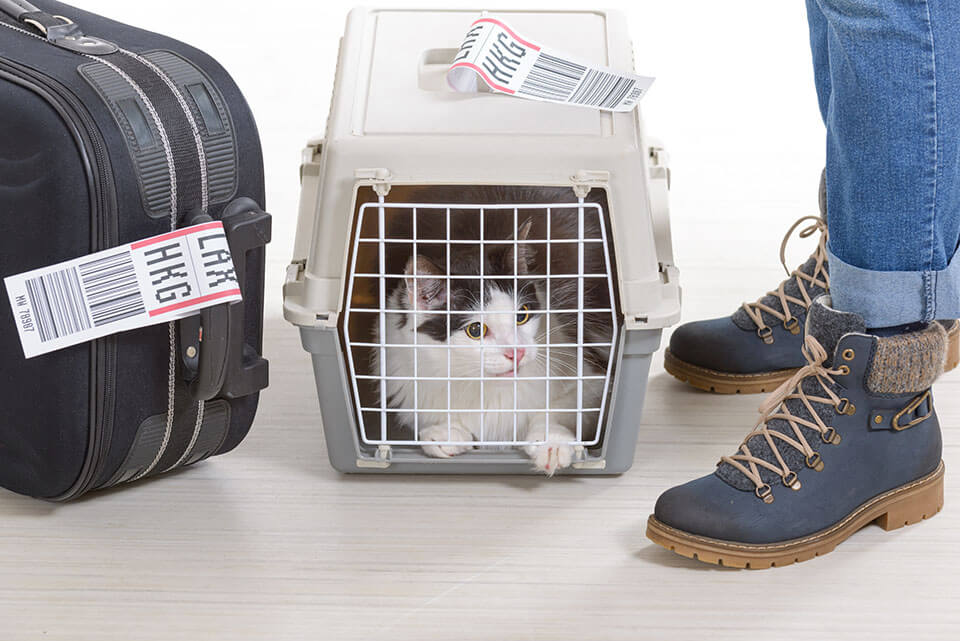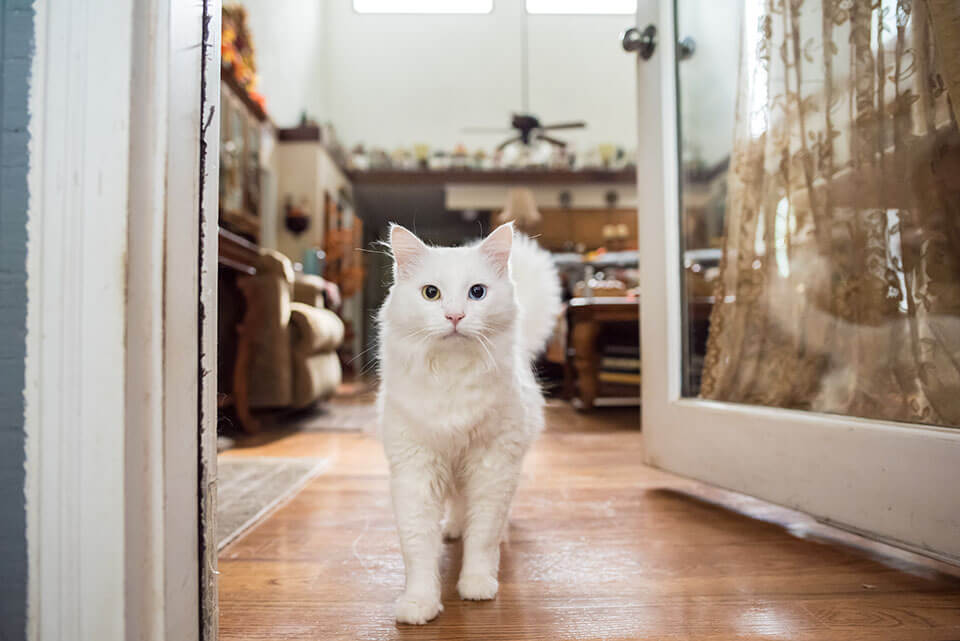5 Useful Tips for Those Moving With a Cat
If you ever lived with
felines, you must know that they are generally territorial beings who are not
the biggest fans of changes. So, if you are moving with a cat, it's time to read some tips and tricks to help
you and your loved kitty get through the process easier. Being the feline
lovers that we are, we've compiled only the most useful of hacks, so let's get
to them

The Best Tips for Moving With a Cat
If you want to succeed in relocating
efficiently with
cats you'll have to endure some planning. While feline pets generally
aren't the biggest fans of change, you should know that any relocation
with pets has to be thoroughly thought out - even if you own the
most easy-going of animals. So, to assist you, we've compiled a list of the best tips to take into
consideration prior to relocation, during your move, and after it, and avoid
any relocation
mistakes that commonly arise.
Is Moving Stressful for Cats?
There might be a lot of questions going through your head: are cats traumatized by moving? Is
moving with a cat bad? Will my pet ever adjust to the new setting? Easy there, relocation isn't the end of the world -
neither for you nor your feline. Of course, nobody enjoys relocation - not even
people.
So, if you, who can
understand what a move is, can still experience anxiety about moving out, understand your pets might as
well. And while you should aim for a stress-free move, you should also try to educate
yourself about stress-inducing factors
for your furry friend, so you know how best to deal with them.

#1 Make Sure You Prepare Your Feline for the Upcoming Changes
The first set of our relocation tips relate to the things on your to-do
list that are to happen prior to the actual relocation. These will
help your feline experience the
transition smoothly and not get too fussy about it. But, in order for that
to happen, you'll have to organize your move and introduce your pet to objects such
as the carrier.
Moving a Cat Requires Introducing Them to a Carrier
Figuring out how to
move with a cat from a house to an
apartment or
another address will require a few relocation hacks. Because most pets associate carriers with the visit to
the vet, they are not always too eager to enter their transporters on
demand. However, not all cats have this experience. If your veterinarian comes
to your home, or the animal never experienced trauma from visiting the vet,
they might not have a problem with going into a carrier.
Still, it's a good idea to
place the carrier somewhere in the house,
and leave it open for a few days or even weeks. That way, your animal will have
the opportunity to explore the space at its own pace. It can smell it, go
inside or even sleep there. The object might become more alluring if you place
their blanket, toy, or food inside. After some time, that is, when the
relocation comes, they should be okay with the transporter enough so that it
doesn't cause stress.

#2 Update the New Home Address on the Collar of Your Pet
Just as you'll have to deal with bureaucracy and change your voter registration, your address
and update your driver's license, so should your cat. Most importantly, you'll
want to update the collar information of
your animal. That is because, in the first days of your move, your furry
friend might not agree with your decision on where to live, and so they might
choose to escape. Don't worry, that doesn't happen too often, but just in case,
update the address prior to the move, and consider having them chipped, if they
already aren't.
Check Their Health With the Vet
No matter if you decide to get a chip at this moment or not before you
move, you should still remember to pay a visit to the vet. In case you are
relocating further away, you'll have to
take your animal's documentation and could even get a recommendation from
their health expert on which medical facility to transfer them for their
obligatory shots. Likewise, they could recommend ways to deal with the cat's
relocation anxiety in relation to their medical history, and might even
recommend calming medication if they consider them necessary.

#3 Keep Your Pet Secure While a Moving Company Employees Are Around the
House
Cats tend to get used to the way a house is organized, so relocating
furniture might be a stressful experience for them. Not to mention
that they might want to explore the
house while it's being packed up and moved, leading to a possibility of
injuries. Because of that, it is a good idea to keep your feline at bay while relocating
large items. This would best be done by closing them up in a
different room, at a pet hotel or a friend's place.
Try to Leave Your Pet With a Friend Prior to Relocation
While we understand
that you might want to avoid unnecessary relocation of your feline, if you are
trying to figure out how to move with cats safely, you might have
to leave them with your friend for a few days as a way of preparing your place for movers. As mentioned earlier, cats are
curious and fast, so they can easily slip out of rooms you're trying to keep
them in. So, depending on how long the move will last, you should consider leaving them with someone else,
as well as their food and litter box. Of course, if a shorter relocation is at
hand, there might not be a need for that.
Make
Sure the New Apartment Is Deeply Cleaned Before Relocation Day
Before you relocate
to your future apartment, you should make sure that it has been deeply cleaned.
Kitties are very sensitive to smells, so if an animal lived there prior to your
feline, their lingering scents might
have stayed. That is a problem because it prolongs how long it will take
your pet to consider the territory their own. So, in addition to doing your move-out cleaning, ensure that the new space
is sparkling as well.
On the Relocation Day, Place Your Cat in a Carrier
As movers
won't move living beings - including pets and plants, it will be up
to you to relocate your feline. That means that when the relocation day comes,
you have all their basics on you -
like a small litter box and some food. Of course, you'll need to put your furry
friend inside of a container. And while you might feel like it's a good idea to
let them out of it while you're in the car - resist this urge. It could
complicate matters further, and trust us, even if your feline seems anxious in
the transporter, they will calm down for a while.

#4 Give Them Time to Adjust to the Place
Once you've arrived
at your destination, you'll want to feline-proof the home as well as close all
windows and doors. You'll want to place their food and litter box in the space
as well, as these are important for your pet to understand this is their home
now. Most often, when a feline gets to an unknown place, they'll hide beneath furniture and in corners, before they start to
slowly explore the space. Try introducing them to the space room by room, and
if they seem too stressed by it, try leaving them in one space until they feel
comfortable.
How Long Does It Take for a Cat to Get Used to a New Home?
Every feline is different, and the number of days or weeks they will require to feel safe may vary in relation to a number of factors. Still, if you notice your kitty is still not settling in after a few weeks, consider talking to a vet. However, consider the following factors, and how they relate to your pet. Here are the main ones that will help you get an idea of when the house will truly become a home to your kitty:
●
Age is an important factor of accommodating -
Kittens tend to feel safe while a change is underway more easily, as they don't
have too much experience under their belt. On the other hand, the older they
are, the harder it will be for them to adjust to an unknown territory. They
might struggle to get used to different smells and spaces, however, don't
worry. Once they manage to leave their scent around, feel their litter and food
scents, they'll start adjusting more.
●
Trauma can increase the length of the adjustment period - If your kitty survived a trauma, or maybe even lost a few of its nine
lives, a change might be a more difficult thing to go through. They might feel
more anxious or be more fearful than a regular animal would. So, just make sure
you're patient with the transition.
● A big change in the environment can be impactful - If you and your loved animal are changing cities, or going from a country scape to an urban one, the change itself might be more impactful. Even if your kitty stays in the house, they are attuned to environmental factors like noise, air, and humidity, and might be a bit more confused at first.

#5 Keeping Up Your Pet's Day-to-Day Routine Will Help Them Adjust
Quicker
It's good to keep
your, and your kitty's routines the same after a big move. This will give them
a sense of comfort and normality and could get you to feel more safe as well.
Cats tend to wake up and go to sleep with their owners, so keeping these times as
normal will surely make an impact. Likewise, keep the feeding periods and periods of cleaning their litter tray the
same. If you are relocating with a new person, be prepared that your feline
might need some time to adjust to their new roommate.

Use the App to Compare Moving Companies and Find the Best One to Help
You Move Today
Now that you know how to relieve your kitty's relocation anxiety, you should think about your own. And with our moving app, soon there won't be any. If you are on the lookout for movers to help you relocate, you should get familiar with the first app for moving - Mod24. Mod24 features make up a one-of-a-kind moving company app that lets you find relocation rates, compare companies and quotes, find out how much movers cost, and do all of this out of the comfort of your own home.
Even more
importantly, it allows you to avoid the common and grave relocating industry challenges and issues that
might complicate your move - one of them being relocation
scams. Our platform will not only introduce you to the most reliable
and safe companies but let you choose the one that suits you best among all of
these credible, licensed companies. So,
just download the app, and we'll do the rest. And if you have any questions
regarding our platforms, feel free to contact us in just a few simple clicks.

Tips for Stress-Free Apartment Moving
Are you excited about moving? Although you’re moving to a better place, thanks to a huge pay raise, ...

How to Live on Your Own - All the Tips You Need
Approximately 36.2 million people live on their own in America. If your dream is to be part of this ...

Ethical Leadership in Moving Services
Moving services often face ethical challenges like hidden fees, mishandled belongings, and unfair l...